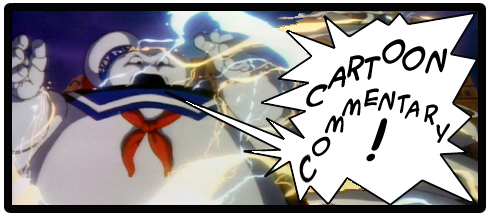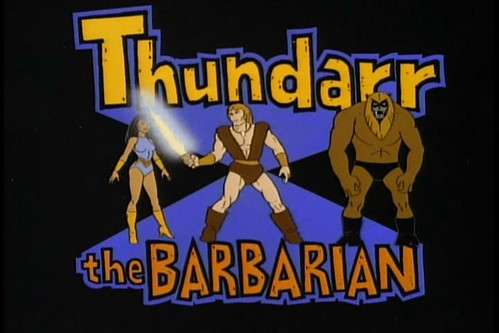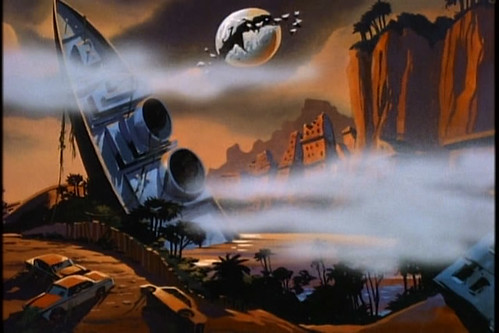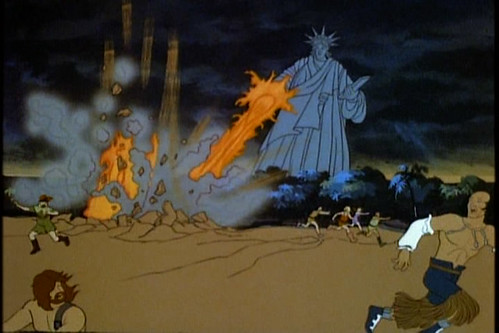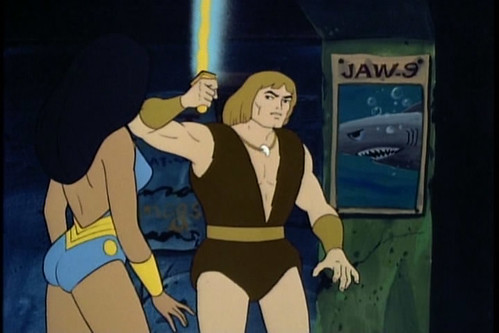So I finally received my copy of the Warner Bros. Presents Saturday Morning Cartoons, 1980s DVD set, and more importantly I’ve finally had the first opportunity to watch a full episode of Thundarr the Barbarian since I was a kid. I don’t know about anyone else, but for the most part I have a weird mental block on watching cartoons on Youtube or Hulu. It’s something about the (typically) lower audio/video quality, the small viewable screen size, having to load all the separate parts (in youtube’s case), and more importantly the fact that sitting down in front of the computer tends to put me in the mind set of work. I spend about 6 hours a day in front of a monitor for the day job, and a couple hours each night working on articles for Branded. The last thing I want to do is try and watch stuff on the computer as well. Anyway, the point is that I haven’t brought myself to watch any of the Thundarr episodes online and since I don’t have access to Boomerang with my cable service I’ve had to wait on seeing the show.
The downside of the WB Saturday Moring collections is that they pretty much only feature single episodes of the included series, so we only get one episode of Thundarr the Barbarian. In WB’s defense it is the first episode (in the production order I believe), titled Secret of the Black Pearl, which was released in 1980. Even though it’s only 22 minutes of the series, what a 22 minutes it is! Though I grew up mainly on He-Man, I did watch a bit of Thundarr and I seem to recall being really jazzed by the show. If there were ever any 80s cartoon series that I thought aged well, Thundarr would probably be at the top of that list.
The opening sequence of the series falls into the style of expositive cartoon intros, which I’m typically not a fan of (unless the story is told with a catchy theme song, ala Galaxy High), but I have to give it a pass because it’s so well done. The writers and artists managed to cram so many ideas into those first 60 seconds that I felt like I’d already watched a few episodes before the show even really began. There’s something outright magical about picking the perfect narration and matching it to great artwork and key scenes that describe the setting, where every single word and image counts, and there’s absolutely no fat to the storytelling…
“Thundarr the Barbarian! The year 1994. From out of space comes a runaway planet hurtling between the Earth and the Moon, unleashing cosmic destruction. Man’s civilization is cast in ruins! 2,000 years later Earth is reborn. A strange new world rises from the old, a world of savagery, super-science and sorcery. But one man bursts his bonds to fight for justice with his companions Ookla the Mok and Princess Ariel. He pits his strength, his courage, and his fabulous sun sword against the forces of evil. He is Thundarr the Barbarian!”
Another aspect of the opening that I really dig is that unlike most of the Saturday morning cartoons of the 70s, Thundarr actually delivers on what that sequence promises, in particular the visuals. It’s one thing to design an intriguing show concept, and quite another to deliver on it, especially considering the cost and time constraints of television animation, and the pervading 70s era ideal of dumbing down cartoons to “protect” the young viewing audience. When the key phrase of the day was limited animation, it’s refreshing to see a production take the time to really create a dynamic and believable post-apocalyptic Earth for these characters to run around in, not to mention filling that world with interesting background characters, monsters and villains. After the promise of a crazy futuristic fantasy setting my expectations were kind of high and it was one of the first things I was really looking for in the episode.
Right from the get-go the episode delivers as we pan across an overgrown landscape rife with the rotting carcasses of old trucks and aircraft. The episode has a really murky feel to it because of its dark color palette with lots of blues, blacks, greens, greys and purples. Again, not to keep harping on the 70s, but in an era of bright primary colored cartoons, this was a breath of fresh, albeit murky, air. There was a tangible realism, not necessarily in the rendering, but in the tone that we were really only seeing in feature film animation at the time, and usually only in the more independent stuff coming from places like the Ralph Bakshi studio. Another part of what really added to this realism was a depth of field that the animators achieved by heavily layering in foreground elements over the mid-ground action. There are a lot of shots where the camera p.o.v. appears to be deep in this lush forest, so when Thundarr, Ookla, and Ariel are speeding along a trail there’s a ton of overgrowth blocking the characters. The animators carry this forward to some of the exposition scenes as well, and it just adds a level of believability that’s lacking from a lot of Saturday morning cartoons.
Another promise delivered is the idea of a “…world of savagery, super-science, and sorcery…” In the opening we flash on all sorts of monsters and creatures, as well as wizards and magic, and I was hoping we’d get a glimpse at a few during this initial series episode. Within the first few minutes our heroes run into a miscellaneous gill-man and a whole slew of evil rat-men before we even get an inkling of the plot. Over the course of the episode we get to see Thundarr and the gang in a second battle with the rat-men (on motorcycles no less), as well as running into the evil wizard Gemini, his horde of robotic knights, and the colossus that is the Statue of Liberty brought to life and set upon one of the last pockets of humanity living in the remnants of New York City.
What’s also interesting is that I get the feeling that there aren’t any reoccurring villains. Instead, the gang battle against a series of wizards that each control different areas of the world, who keep a strangle hold on the last vestiges of human society with their knowledge of ancient technology and sorcery. This variety of adversaries ends up adding so much more tension to the adventure as we never know what’s next. It also opens up the episodes to another level of realism in that there’s an opportunity for finality in each plot. In a lot of similar shows a lot of the tension is eradicated by the knowledge that the villain will be back in the next episode no worse for wear.
The one aspect of the show that really surprised me was the level of action and violence. To be honest I’m not really coming from one point of view or another when it comes to the level and execution of action in my cartoons, but I’m so used to non-violent cartoons that when I see one that pushes a little further I get kind of floored. I’m just as happy watching He-Man refuse to punch a living being as I am watching something uber-violent like Akira, though. After reading the Thundarr articles from Fangoria and Fantastic magazines, I was sort of expecting the show to fall on the side of Masters of the Universe. Steve Gerber seemed pretty upset about the extent to which the production was hamstrung by the network standards and practices yearning to please parent’s groups (like Action for Children’s Television.)
If you look at the 1st episode concept art above you can get a pretty good idea of how much the action and adventure elements were calmed down, as well as how much Jack Kirby’s concepts were changed.
But even for these changes and after watching the 1st episode I have to say that there is plenty of decent action. Sure, Thundarr isn’t slicing rat-men in half with his sun sword, but he is using it to knock weapons out of their hands mimicking a more realistic combat. The production team also utilized the tried and true concept of having robotic villains and henchmen leaving the hero of the cartoon open to doing some damage. There’s a scene where Thundarr and Ookla are besieged by a bunch of Gemini’s knights and after knocking one down Thundarr hears the mechanical whirring of the robot’s gears. With this knowledge, in the next sequence he proceeds to run another knight through with his sun sword. The animators even had the knight stare down at his wound as Thundarr stabbed him, which added a kind of disturbing level of reality to the scene.
In another fight sequence, Thundarr ends up kicking some rat-men off their motorcycles, which I would think would be a huge no-no in a network censor’s eyes as that action would be highly mimicable by children. Of course mixed in with are a lot of more traditionally non-violent action scenes. In their first encounter with the rat-men, we mainly see Ookla flinging them by their tails off-camera into their tree fortress. We don’t see any impact for the most part, so it comes off pretty tame as the creatures just silently glide past our heroes. The evil wizard Gemini is also prone to shooting harmless paralyzing eye beams at Thundarr, Ookla and Ariel instead of displaying any sort of real danger or physical harm. So there is certainly a compromise happening on screen.
Because the show does tend towards more realistic violence, and if there’s one good thing I can say about the Warner Brothers DVD release of this episode, it’s that they didn’t go in and muck with it. The WB studio is known for retroactively kiddifying their cartoon releases by editing episodes to match up with today’s ridiculous politically correct environment. They’ve cut down episodes of Johnny Quest and omited episodes of Tom and Jerry from DVD sets, in an effort to erase perceived racy content and violence. In fact I was kind of shocked to see that they left in a shot of the decimated Twin Towers during a pan across the apocalyptic landscape of New York City. It is funny to note that on the back of the DVD case there’s a note that these episodes are intended for an adult audience and that they aren’t recommended for children. Hooey!
The one aspect of the show that I could see myself getting tired of is all of the jokes about the antiquated technology and bits of the old world lying around. For the most part the characters in the show are ignorant of humanity’s original society, and only a select few know about how to use the old technology or even what most of it is. Ariel, whose step-father is a wizard, is well versed in the old culture and she kind of acts as the straight man to Thudarr’s silly barbarian ignorance. There’s a running gag where he’ll see something and think it’s an important clue to solving a plot issue, like a poster for Jaws 9 in a subway scene in this episode, and Ariel will have to point out that it’s just an old movie poster (to which Thundarr basically asks, “What’s a moo-v?”) Sometimes this comes off kind of funny, like in a scene where Thundarr and Ookla steal a helicopter and in a fit of rage while trying to fly the crazy contraption Ookla first rips out the steering column, and then kicks the rest of the control panel out of the chopper causing it to crash (similar humor to the Chewbacca/Millennium Falcon scenes from the Star Wars movies.) But I can see it getting old really quick.
By far, my favorite scene in the episode was the last cinematic battle sequence in which Gemini, approaching a small pocket of humans and our heroes while flying atop a thunder cloud, brings the rotting Statue of Liberty to life, acting as a harbinger of doom for New York (years before the Stay Puft Marshmallow Man even thought about stepping on a church in that town.) Granted, it came out almost a decade before Ghostbusters II and I doubt it was an influence, but there’s something really fulfilling in seeing that iconic statue coming to life and attacking a city, knowing that later on it’ll play the opposite side of that coin (to mix my metaphors.) The statue’s main weapon is her torch which is transformed into a flamethrower laser which she uses to lay waste to the city and harbor, zapping entire buildings at a time. It’s so crazy and over the top, and by far my favorite Statue of Liberty action sequence beating out Remo Williams fighting on the 80s era statue cleaning scaffolding, Ghostbusters II, and the horrible physics and goofy improbability of the first X-Men movie (though maybe not as neat as the Statue reveal in Planet of the Apes…).
Unfortunately Ruby Spears chose to use very general, non-episode-specific end credits sequence, so I’m not sure who specifically wrote the episode. I do know that you can feel the hand of Steve Gerber, Mark Evanier, Buzz Dixon, Jack Kirby and Alex Toth in the overall design and tone. I really loved the episode and I hope Warner Brothers gets off their butt and puts out a proper full series release for the show some day. I enjoyed this episode so much, I might have to forgo my comfort and watch more on youtube…
By the by, that Thundarr article from Fangoria magazine I posted a little while ago seems to be a little bit at odds with itself considering Buzz Dixon wrote both it, and was apparently a writer on the show. I guess since Fangoria was just getting off teh ground the editor was fine with self-promotion pieces to fill up the zine, but it makes you wonder…

